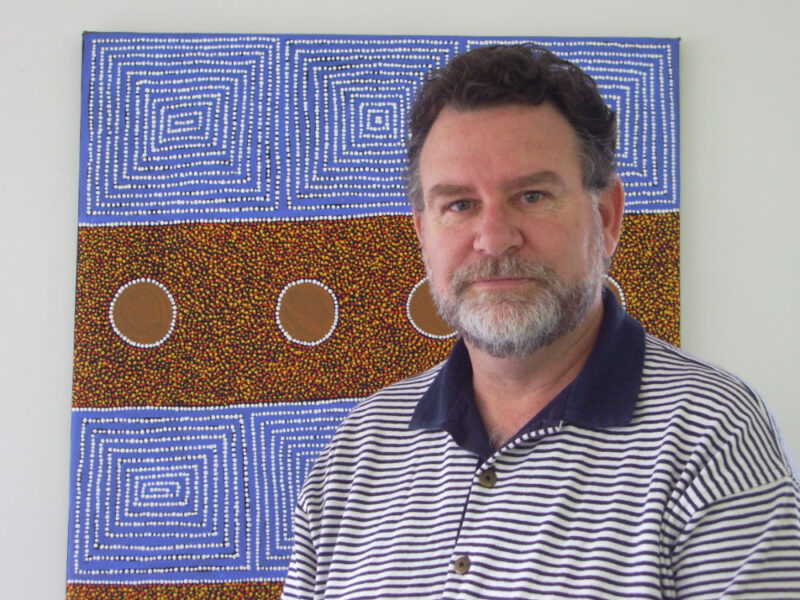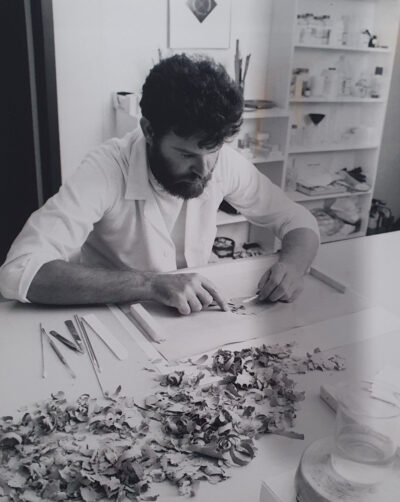 Introduction by Cobus van Breda.
Introduction by Cobus van Breda.
I first met Kim in the early 1990s when I was a conservation student and volunteering in the paper lab at the National Library of Australia. Kim was a great mentor to me; his calm and patient approach to all conservation problems and unfailing sense of humour were exactly what I needed. Kim has the gift of carefully building self confidence in young conservators by example; small steps and practical hands-on work. I know that he has had the same tremendous influence on many other young conservators over the last 30 years, all of whom have benefited from his practical approach to often complex problems. I was delighted when he succumbed to my nagging and agreed to write about his experience as a conservator.
Meet a Conservator: Kim Morris
What first attracted you to a career in conservation? How did you get started?
I always had an interest in visual art and while more cartoonist than artist I recognised my technical skills. Originally I planned to become a cartographer however those opportunities were curtailed by government cuts. After five years’ work in the automotive industry I saw a documentary on the restoration of Rembrandt’s Night Watch after its 1975 knife attack. Immediately I knew that this was the career for me. That was the easy part. I had no work experience in conservation; I had no chemistry education.
I scored a lucky break via a contact my father had made at the AWM Research Centre, Ron Gilchrist, who put in a word for me with the then AWM head of conservation. I resigned my job and commenced as a volunteer in the paper conservation lab at the AWM, it was there I met my early mentors, David Button and Kerry McInnis. I also commenced studying basic chemistry at night school. David patiently helped me learn basic paper treatments and put together a folio of work. I applied for the next round of course admissions in 1981, was selected and commenced my undergraduate degree in Conservation of Cultural Materials in 1982. I have Ron Gilchrist to thank for giving me the break I needed to start a long and eventful career in conservation.
What does a typical work day look like at the moment?
Since 2000 I have been the owner, director and senior conservator of Art & Archival, a busy private cultural materials conservation practice based in the Canberra–Queanbeyan region. Art & Archival was started by Kerry Mcinnis is 1981 as a paper conservation practice. Over the years it has grown to be much more diversified, covering the disciplines of paper, paintings, textiles, objects, books, consultancies, training and more.
Private conservation practice often requires a different approach to treatment work than other conservation jobs. Treatments are often governed by the client’s budget. Their preferred treatment needs do not necessarily match the private conservator’s preferred approach. This presents treatment challenges where we often negotiate a treatment compromise with the client that suits their budget and preferred outcomes and rests within our professional code of ethics.
A typical day at Art & Archival is generally busy and always includes good coffee. I generally spend my time talking with my team, advising and assisting them in treatments, undertaking treatment work, business admin, quoting, emailing, talking with clients, developing new projects, etc. A cornerstone of Art & Archival is making sure we have fun while we work so there’s always lots of chat, good music, and at the moment the occasional COVID-19 therapy dog on hand.

Do you have a favourite object or collection that you have worked on?
In the first half of my career I worked for the Australian War Memorial and the National Library of Australia. There are too many favourites in both these collections to name. At the AWM, I gained the most pleasure from treating personal papers, documents and diaries. At the NLA, works on paper from the Nan Kivell Collection, the extensive collection of Ellis Rowan watercolours and objects from the Rare Maps collection are standouts.
At Art & Archival most of the private material we treat is of great sentimental significance to the owner. Personally I feel honoured to be able to treat these items no matter their intrinsic value or the type of material. We treat every object with the same level of professionalism and respect, regardless of value, rarity or condition.
We treat at least several hundred objects every year but standouts are always either something highly treasured by the owner or elements of institutional collections that post significant treatment challenges within budgets. Backing removals remain one of my personal favourites right from the first one I ever completed as a volunteer at the AWM.
Can you think of an experience that has changed your perspective on conservation or how you approach your work?
The experience of working privately demonstrated the importance of good communication between client and conservator. Ultimately it is the owner’s choice as to how much work is done because they are the ones paying for our services. I always make sure the client is kept informed on treatment options, progress and if any changes in approach need to be made. I see good honest exchange with my clients as essential in the success of any conservation treatment project.
Has working in conservation taught you any skills that you use in other areas of your everyday life? Or do you bring everyday skills into the conservation lab?
I brought my natural dexterity skills into my conservation career and these have served me well throughout. I am a much better practical conservator than an administrator and that is why I chose to change career direction in the late 1990s to move full-time into private conservation practice. At Art & Archival you never know what object will come through the door. This has taught me flexibility and diversity in my treatment approaches, things I believe are a must for all private conservators.
What is the one thing you wish more people knew about conservation?
Conservation is an important component of the long-term preservation of cultural objects. It requires knowledge, materials understanding, skill, ability and professionalism to properly and appropriately conserve collection materials. The profession is full of very clever people but they need ongoing treatment time to maintain confidence and skills. We can very quickly become de-skilled if we don’t maintain consistent treatment practice. I don’t think this is always recognised in institutional conservation where so much work time is consumed by administrative duties. As private conservators we spend most of our time at the treatment bench and are by default confident in our treatment practices. I would like to see an acknowledgement in the cultural sector that more time should be allocated to remedial collection treatment to keep practicing conservators from being de-skilled.

Anything else you might like to reflect on and share?
Like many conservators who started their careers in the 1980s, the sun is slowly starting to set on my career. As I contemplate the future I look back on my 40 years in conservation with fondness and gratitude to something that started with getting a break. Remembering how I started grounds me and reminds me of all the fantastic people I’ve worked with, employed, mentored and trained, and to whom I’ve given a break.